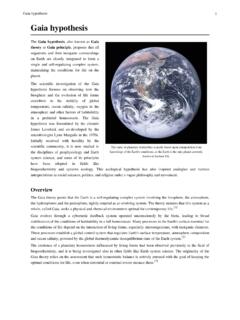Transcription of PointNet++: Deep Hierarchical Feature Learning on Point ...
1 pointnet ++: Deep Hierarchical Feature Learning onPoint Sets in a Metric SpaceCharles R. QiLi YiHao SuLeonidas J. GuibasStanford UniversityAbstractFew prior works study deep Learning on Point sets. pointnet [20] is a pioneer in thisdirection. However, by design pointnet does not capture local structures induced bythe metric space points live in, limiting its ability to recognize fine-grained patternsand generalizability to complex scenes. In this work, we introduce a hierarchicalneural network that applies pointnet recursively on a nested partitioning of theinput Point set.
2 By exploiting metric space distances, our network is able to learnlocal features with increasing contextual scales. With further observation that pointsets are usually sampled with varying densities, which results in greatly decreasedperformance for networks trained on uniform densities, we propose novel setlearning layers to adaptively combine features from multiple scales. Experimentsshow that our network called pointnet ++ is able to learn deep Point set featuresefficiently and robustly. In particular, results significantly better than state-of-the-arthave been obtained on challenging benchmarks of 3D Point IntroductionWe are interested in analyzing geometric Point sets which are collections of points in a Euclideanspace.
3 A particularly important type of geometric Point set is Point cloud captured by 3D scanners, , from appropriately equipped autonomous vehicles. As a set, such data has to be invariant topermutations of its members. In addition, the distance metric defines local neighborhoods that mayexhibit different properties. For example, the density and other attributes of points may not be uniformacross different locations in 3D scanning the density variability can come from perspective effects,radial density variations, motion, prior works study deep Learning on Point sets.
4 pointnet [20] is a pioneering effort that directlyprocesses Point sets. The basic idea of pointnet is to learn a spatial encoding of each Point and thenaggregate all individual Point features to a global Point cloud signature. By its design, pointnet doesnot capture local structure induced by the metric. However, exploiting local structure has proven tobe important for the success of convolutional architectures. A CNN takes data defined on regulargrids as the input and is able to progressively capture features at increasingly larger scales along amulti-resolution hierarchy.
5 At lower levels neurons have smaller receptive fields whereas at higherlevels they have larger receptive fields. The ability to abstract local patterns along the hierarchyallows better generalizability to unseen introduce a Hierarchical neural network, named as pointnet ++, to process a set of points sampledin a metric space in a Hierarchical fashion. The general idea of pointnet ++ is simple. We firstpartition the set of points into overlapping local regions by the distance metric of the underlyingspace. Similar to CNNs, we extract local features capturing fine geometric structures from smallneighborhoods; such local features are further grouped into larger units and processed to producehigher level features.
6 This process is repeated until we obtain the features of the whole Point design of pointnet ++ has to address two issues: how to generate the partitioning of the Point set,and how to abstract sets of points or local features through a local Feature learner. The two [ ] 7 Jun 2017are correlated because the partitioning of the Point set has to produce common structures acrosspartitions, so that weights of local Feature learners can be shared, as in the convolutional setting. Wechoose our local Feature learner to be pointnet . As demonstrated in that work, pointnet is an effectivearchitecture to process an unordered set of points for semantic Feature extraction.
7 In addition, thisarchitecture is robust to input data corruption. As a basic building block, pointnet abstracts sets oflocal points or features into higher level representations. In this view, pointnet ++ applies PointNetrecursively on a nested partitioning of the input 1: Visualization of a scan captured from aStructure Sensor (left: RGB; right: Point cloud).One issue that still remains is how to generateoverlapping partitioning of a Point set. Eachpartition is defined as a neighborhood ball inthe underlying Euclidean space, whose param-eters include centroid location and scale.
8 Toevenly cover the whole set, the centroids are se-lected among input Point set by a farthest pointsampling (FPS) algorithm. Compared with vol-umetric CNNs that scan the space with fixedstrides, our local receptive fields are dependenton both the input data and the metric, and thusmore efficient and the appropriate scale of local neighborhood balls, however, is a more challenging yetintriguing problem, due to the entanglement of Feature scale and non-uniformity of input pointset. We assume that the input Point set may have variable density at different areas, which is quitecommon in real data such as Structure Sensor scanning [18] (see Fig.)
9 1). Our input Point set is thusvery different from CNN inputs which can be viewed as data defined on regular grids with uniformconstant density. In CNNs, the counterpart to local partition scale is the size of kernels. [25] showsthat using smaller kernels helps to improve the ability of CNNs. Our experiments on Point set data,however, give counter evidence to this rule. Small neighborhood may consist of too few points due tosampling deficiency, which might be insufficient to allow PointNets to capture patterns significant contribution of our paper is that pointnet ++ leverages neighborhoods at multiple scalesto achieve both robustness and detail capture.
10 Assisted with random input dropout during training,the network learns to adaptively weight patterns detected at different scales and combine multi-scalefeatures according to the input data. Experiments show that our pointnet ++ is able to process pointsets efficiently and robustly. In particular, results that are significantly better than state-of-the-art havebeen obtained on challenging benchmarks of 3D Point Problem StatementSuppose thatX= (M,d)is a discrete metric space whose metric is inherited from a Euclidean spaceRn, whereM Rnis the set of points anddis the distance metric.
![arXiv:0706.3639v1 [cs.AI] 25 Jun 2007](/cache/preview/4/1/3/9/3/1/4/b/thumb-4139314b93ef86b7b4c2d05ebcc88e46.jpg)

![arXiv:1301.3781v3 [cs.CL] 7 Sep 2013](/cache/preview/4/d/5/0/4/3/4/0/thumb-4d504340120163c0bdf3f4678d8d217f.jpg)
![@google.com arXiv:1609.03499v2 [cs.SD] 19 Sep 2016](/cache/preview/c/3/4/9/4/6/9/b/thumb-c349469b499107d21e221f2ac908f8b2.jpg)













